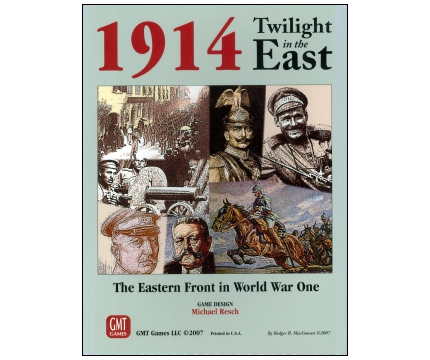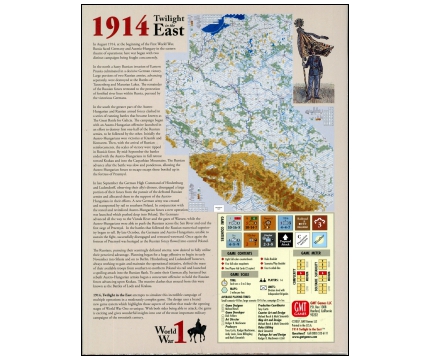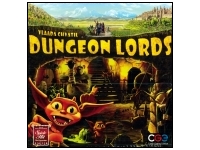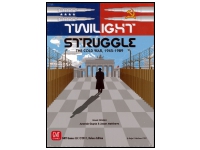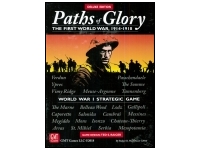-
-
-
-
-
-
Din kundvagn
Din kundvagn är tom. -
-
-
-
-
-
-
1914 - Twilight in the East
-
8.01 8.01 / 10, (212 röster) - Sätt betyg
-
-
Antal spelare: 1 - 6
Speltid: ?
Ålder: 12+
-
Regelspråk:

Försälj. rank: 4791/16222
-
-
589 kr
Ej tillgänglig
Tyvärr går det inte att beställa 1914 - Twilight in the East längre.
Det är inte heller troligt att vi kommer få hem produkten igen.
Önskelista: För att kunna använda önskelistan måste du ha ett användarkonto och vara inloggad.
-
-
-
Innehållsförteckning
Counters: Eight full-color counter sheets (2240 counters)
Maps: Four 22" x 34" maps (one back-printed)
Rule Booklet
Scenario Booklet
9 different army organizational charts (5-1/2" x 8-1/2")
Four six-sided dice
Produktbeskrivning
1914, Twilight in the East models the battles that took place in Prussia, Poland and Galicia during the first year of World War One. Beginning with the Russian invasions of Prussia and Galicia in August and ending after the Battle of Lodz in December, it recreates the ebb and flow of the huge forces sent marching across the Eastern Front in 1914.
Designed by Michael Resch, and developed by Dick Vohlers, the game has been comprehensively researched using a great array of resources, including the military archives in Vienna, Austria. The game's Order of Battle has been thoroughly researched and is by far the best used by any game on the subject. Based on his experience with other WWI game systems, Mike has written streamlined rules so that not only is it playable, but it's focused on those aspects of warfare that made the opening stages of WWI so unique. The game is exciting and gives wonderful insights into one of the most important campaigns of the twentieth century.
The Game System
1914, Twilight in the East game system's goal is to model operational campaigning as it was in the early months of WW1: A period of maneuver before the deep trench-line stalemate of the later years set in; of learning the harsh lessons of a new type of warfare; where old doctrines derived from the lessons of the Wars of German and Italian Unification were modified or discarded; and when new technology, previously unavailable, began to show its value. To achieve the goal of modeling this time period accurately the various scales - combat unit size, hex size and the length of time represented in each game turn - have been carefully selected to allow them to blend together wisely.
1914, Twilight in the East game system is brand new. Of course, since ConSim gaming has a long (glorious) developmental history, players will recognize old concepts - attack and defense strengths, movement allowances, etc. - but some concepts are new or are used in an unfamiliar manner. The following is a summary of the most important aspects of the game system.
The military units depicted in 1914, Twilight in the East include four distinct types: combat and artillery units and fortress and supply units; the two most important unit types are combat and supply units.
Infantry and Cavalry combat units represent front-line fighting troops and are typically multi-step units. (A unit's attack strength doubles for the number of steps in the unit.) Most combat units of division or independent brigade-size are termed 'Formations' and are represented by two counters each: a Combat Unit and an Attachment Counter. The Combat Unit marks the formation's location on the map, while the Attachment Counter is placed on an off-map organizational display to record the formation's attachment to an Army (and possibly Corps) and, most importantly in game terms, the formation's current Combat Effectiveness Status. A unit's base combat effectiveness number measures intangibles like organization, training, leadership, morale and stamina. A unit's fluctuating combat effectiveness status represents its changing combat readiness; it fluctuates up and down due to combat, supply status, forced marching and recuperation.
Supply units belong to 'Commands', either Army or Corps-level. Major and Minor Depot units represent the supply dumps for an army and independent corps respectively and their location on the map marks the position of the railheads. Corps Train units represent the numerous corps-level supply columns continuously moving between the combat troops and their supply dumps in the rear.
The Sequence of Play employed in 1914, Twilight in the East is a variation of the common 'You-go-I-go' system. The primary function of most of these phases is self-evident; therefore only a few of the phases will be explained in more detail. Each game turn consists of a Russian Player Turn followed by a Central Powers Player Turn with each player's turn structured in the following manner:
1. Reinforcement and Withdrawal Phase
2. Attachment Phase
3. Pontoon Bridge Phase
4. Supply Phase
5. RR Engineering Phase
6. Phasing Player Movement Phase
7. Non-Phasing Player Counter Movement Phase
8. Phasing Player Attack Phase
9. Non-Phasing Player Counter Attack Phase
10. Post-Combat Phase
In 1914, Twilight in the East, armies conduct their activities within an area of operations termed an 'Area of Attachment.' During the Attachment Phase every army's 'Area of Attachment' must be defined and is done so by simply placing a counter-sheet spine on the map to delimit each army's area. All units within an army's area are attached to that army. (How many Corps Commands may be found inside an area is limited.) One needs only look at a historical atlas of WW1 to see such delimited areas of operation.
The primary effect of a unit's attachment, determined during the Attachment Phase, is the assignment of a supply source. In 1914, Twilight in the East, army-level depot units either supply corps-level train units that supply combat and artillery units or supply combat and artillery units directly. Very importantly, only units 'attached' to a respective Command may be given supply by that Command's supply units. To place a unit 'in-supply' a path must be traced from the supply unit to the unit seeking supply within the limited range of the supply unit. A player may elect to flip a supply unit to its extended side to increase its range, but in doing so, reduces the amount of combat supply that may be distributed. (Supply units bear supply range and supply capacity numbers which work in inverse to each other.)
The structure of the movement and combat resolution sequence in 1914, Twilight in the East allows both players to move prior to combat and then allows both players to attack if they desire to do so. During a player's movement or counter-movement phase he may move all, none or some of his units within the limits of the rules. If however the player would like to increase a units movement allowance he is able to do so through the Forced March procedure. Such units may increase their movement allowance but risk a reduction in combat effectiveness.
The format for combat resolution is possibly the most unique concept within the game. It consists of three inter-related steps that allow a clear delineation of victory in battle to be sometimes hard to determine. A successful attack that forces a defender to retreat could cost the victor more step losses and/or combat effectiveness status reductions than imposed upon the defender. On the other hand it could go the other way round.
To resolve an individual combat, players first calculate the combats odds, apply any applicable odds column shifts and then cross reference a dice roll on the CRT. This result determines if there will be any retreats or modifiers for the Step Loss Results Table. Next the Step Loss Results Table (SLRT) is referenced; here several factors come into play. To determine which SLRT column to use the 'Battle Magnitude' must first be determined (that is, the number and size of participating units); the greater the battle's magnitude the greater the possible number of casualties to be suffered. The next primary factor is the amount of artillery the opponent possesses (you guessed it, the more artillery the higher the casualties). Once the number of casualties has been determined players must check to see if their unit's combat effectiveness has been reduced. The main factors working here are the number of losses suffered and the distance of any retreat in relationship to the unit's current combat effectiveness. Units with high combat effectiveness can withstand a considerable amount of pain. Those with low base combat effectiveness or reduced effectiveness are another story.
Players will find that each combat is unique. First off, factor counting is not an issue for generally unit strengths are not known to the opponent. In addition, the number of variables acting upon combat resolution is high enough so that players really need only concentrate on placing their troops in the most advantageous position possible and then hoping for the best.
Also very important to the time period and simulated well in 1914, Twilight in the East are the unique characteristics of cavalry troop units and the folly of pre-war Strategic plans. The Strategic Plan rules with their inherent movement restrictions and victory point incentives are intended to be a simple mechanism to start the game in a historical direction. Due to their nature the Strategic Plan rules act upon the game for only a short period of time. The unique qualities of cavalry are represented by a series of special rules. Primarily cavalry is given the ability to react every time an enemy unit moves adjacent, thereby allowing it to fulfill its screening and flank guard role. 1914, Twilight in the East models an occurrence so common in 1914 of cavalry attempting much and fatiguing itself in the process.
Hidden within this game system's unit characteristics, supply, movement and combat resolution rules is the actuality that individual units, but more importantly groups of units (i.e. Armies), become combat ineffective and need time to rest and recover. Ever wonder why what looked like a promising offensive was forced to halt? It wasn't because whole units were destroyed (except in a few special cases, such as at Tannenberg, nowhere were whole units eliminated during 1914). During WW1 whole armies were forced to order a halt due to the fact that not enough units were deemed sufficiently ready for further offensive action. To reduce the risk of this occurrence great care was taken to form reserves and commanders were forced to rotate units in and out of the front-line as their battle readiness fluctuated. Fluctuating combat readiness and its effect on the campaign is what makes the 1914, Twilight in the East game system such a good model. Players will find that the ability to keep one's forces combat ready while diminishing the opponent's readiness is the key to success.
Scenarios
All the primary scenarios allow both sides to be simultaneously on the offensive and defensive on different parts of the battlefield. Armies that were on the offensive one turn can quickly find themselves on the defensive a turn later. The game includes seven scenarios; four utilizing one map and three utilizing multiple maps. The scenarios are:
1 - The First Battle of the Masurian Lakes, September 6 to September 20 (1/2 map, six turns). First Masurian pits the reinforced German Eighth Army, flush with its success at Tannenberg, against a waiting Russian First Army. The forces facing each other are roughly of equal size which makes for a perfect introductory scenario where players can learn the important concepts of play.
2 - The Battle of Lublin, Aug 23 to September 9 (1 map, eight turns). The scenario depicts the advance of the Austro-Hungarian First and Fourth Armies toward Lublin and Chelm. The Austro-Hungarian's initial attacks struck and defeated the under-strength Russian Fourth and Fifth Armies. This forced the Russians to send south the newly formed Ninth Army that was mobilizing in the Warsaw area. Stavka had planned to use the Ninth Army to advance toward Berlin over Posen. Reinforced by over 9 new infantry divisions the Russians were able to stop the Austro-Hungarian onslaught short of Lublin and turned defeat into victory.
3 & 4 -The Great Battle for Galicia, August 23 to September 20 (two versions either with 1 or 2 maps, twelve turns). On a front extending from the Romanian border to the Vistula River, four Austro-Hungarian armies clash with four Russian armies. Conrad von Hotzendorf, the defacto Austro-Hungarian commander, commits his forces to a spoiling attack which, although ultimately unsuccessful, detours Russian plans to invade Germany with a thrust towards Berlin. Russian pre-war plans were so poorly laid that the campaign, even though reinforced by an entire additional army, is a close run battle.
5 - The Tannenberg Campaign, August 16 to September 20 (1 map, fifteen turns). The Tannenberg Campaign culminated in the Battle of Tannenberg where Generals Hindenburg and Ludendorff became famous. Two Russian armies, later reinforced by a third, attempt to envelop a lone German army and in the end, historically, are shattered and driven from Prussia.
6 & 7 - The Grand Campaign, August 16 to December 19 (5 maps, two versions either forty-four or forty-seven turns). The Grand Campaign game combines the Tannenberg Campaign and Great Battle of Galicia and continues the war into October, November, and December. Players will see the magnitude of this campaign and learn of the incredible number of losses sustained, as their armies are smashed and recover to fight again.
-
Speltyp: Krigsspel
Kategori: Första Världskriget, Tärning, Hexrutor, Simulering
Tillverkare: GMT Games
Länkar: Tillverkarens hemsida, BoardGameGeek
Taggar: Lägg till/editera tags
Recension(er)
Bästa WWI-spelet - för tålmodiga
Rackarns, vilket spel! För den som vill veta något om och utforska detaljer om vad som egentligen hände på "den glömda" östfronten under hösten 1914: sluta leta! Köp denna pärla bland krigsspel, som inte bara har tunga, men ändå tydliga, regler, utan även top notch komponenter. Ta bara kartan som är ett mästerverk - både estetiskt och designmässigt. Spelbrickorna är tydliga och snygga även dem. Väldigt lite errata är det också - trots att spelet är så massivt och stort.
Nu är det bara att vänta på västfronts-varianten!
Inte för nybörjaren dock och heller inte för dem som tänkt sig en trevlig liten "spelstund". Spelet kräver många timmar och mycket engagemang. Men det är värt varenda minut för dem som vet hur man avnjuter spel av denna kaliber! Krigsspelarnas motsvarighet till gastrnomisk upplevelse är vad detta spel erbjuder.2009-02-26 av: lundinandreasRecension 1 av 1
-
-
Personer som har köpt 1914 - Twilight in the East har också köpt
-
-
1914 - Twilight in the East
589 kr
Ej tillgänglig
-
-
Kundtjänst
Om du har några frågor eller funderingar är det bara att höra av dig till oss.
E-post: info@worldofboardgames.com
Telefon: 090 - 205 92 11
Adress: Björnvägen 11, 906 40 UMEÅ -
Leveranstid och fraktpriser
Ordrar med varor vi har i lager, och som kommer in innan 12:00 på vardagar, skickas normalt samma dag och har sedan en leveranstid på 1-3 dagar.
Fraktkostnaden är 49 kr med Schenker - Ombud, 75 kr med Postnord - Ombud och 175 kr för hemleverans med Postnord. Företagspaket kostar 99 kr. Du ser din fraktkostnad när du går till kassan. Vid beställningar för minst 2000 kr ger vi fri frakt, gäller dock endast Schenker - Ombud och för privatpersoner.
-
-
-






